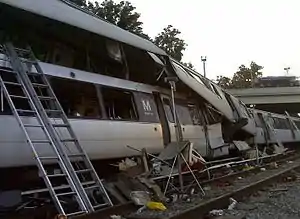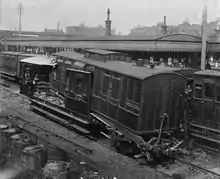Telescoping (rail cars)
In a railway accident, telescoping occurs when the underframe of one vehicle overrides that of another, and smashes through the second vehicle's body. The term is derived from the resulting appearance of the two vehicle bodies: the body of one vehicle may appear to be slid inside the other like the tubes of a collapsible telescope – the body sides, roof and underframe of the latter vehicle being forced apart from each other.[1]


Telescoping often results in heavy fatalities if the cars telescoped are fully occupied. The car riding on top will often be destroyed by the structure of the car below, leaving very little survivable space (although the physics of the incident may reverse the cars' roles). The chances of telescoping can be reduced by use of anticlimbers and crash energy management (CEM) structural systems.
Accidents where telescoping occurred are numerous and include:
- 1864 Shohola train wreck
- 1888 Mud Run disaster
- 1928 Times Square derailment
- 1945 Michigan train wreck
- 1947 Camp Mountain rail accident
- 1952 Harrow and Wealdstone rail crash
- 1957 Lewisham rail crash
- 1962 Rail accidents in Winsford
- 1970 Benavidez rail disaster
- 1972 Chicago commuter rail crash
- 1981 Seer Green rail crash
- 1990 Ursus rail crash
- 2008 Chatsworth train collision
- 2009 Washington Metro train collision
- 2012 Buenos Aires rail disaster[2]
To reduce the chance of telescoping, rail and tramway vehicles are often provided with an anticlimber: a horizontally ridged plate at the end of the chassis, which in a collision will engage with the anticlimber on the next car.
Gallery
 The aftermath of the June 22, 2009 Washington Metro train collision
The aftermath of the June 22, 2009 Washington Metro train collision The aftermath of the St Johns train crash 1898 where the rear two carriages of a passenger train were telescoped by being hit at 8 mph (13 km/h) by a following train.
The aftermath of the St Johns train crash 1898 where the rear two carriages of a passenger train were telescoped by being hit at 8 mph (13 km/h) by a following train. Cars involved in the Mud Run disaster, October 10, 1888
Cars involved in the Mud Run disaster, October 10, 1888
References
- Solomon, Brian (2001). The Heritage of North American Steam Railroads. London: Amber Books. p. 101. ISBN 1-897884-75-3.
- Einat Rozenwasser (25 February 2012). "Un operativo que resultó eficaz pero que ahora revela fallas". Clarín (in Spanish). Retrieved 25 February 2012.
